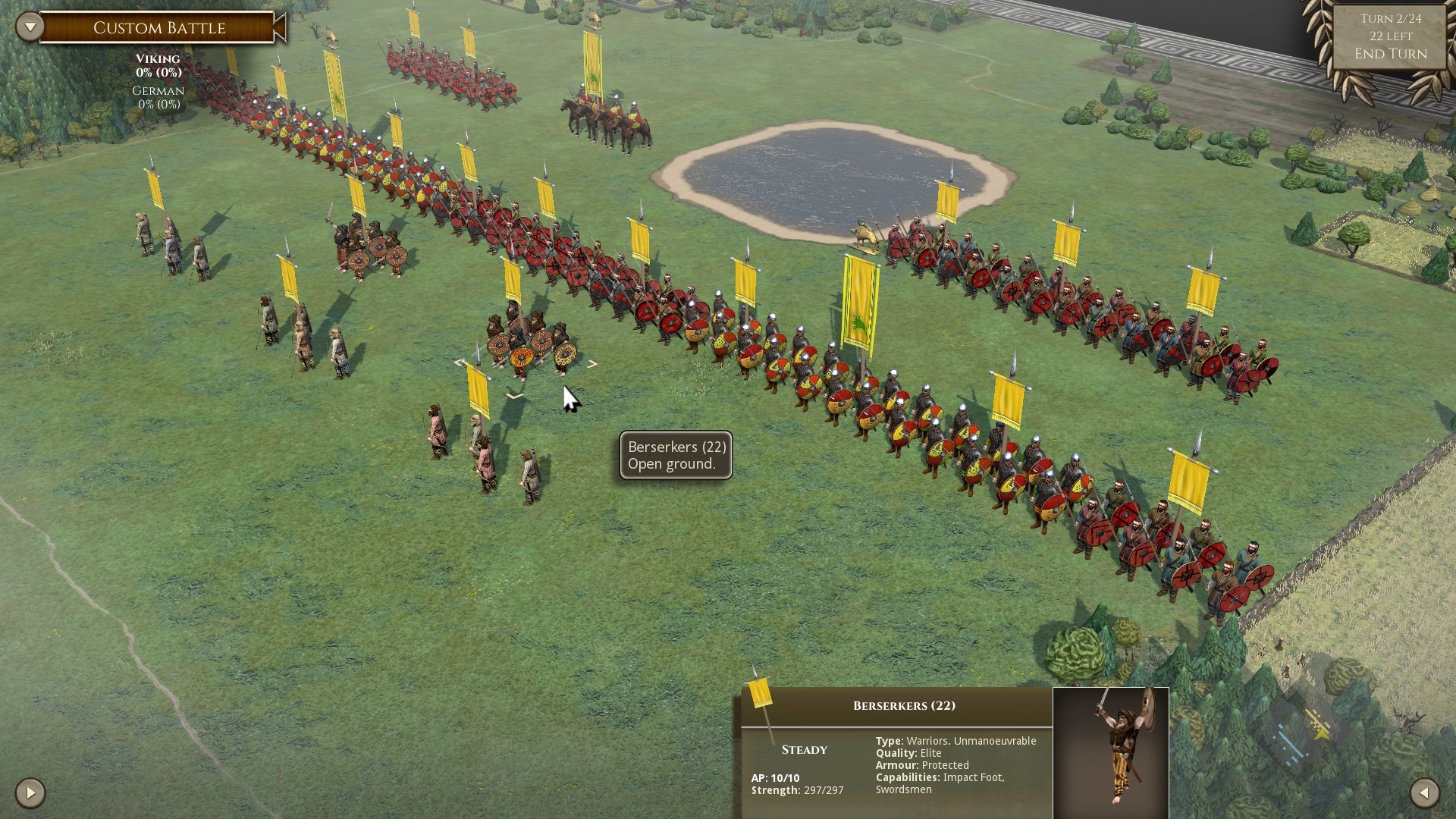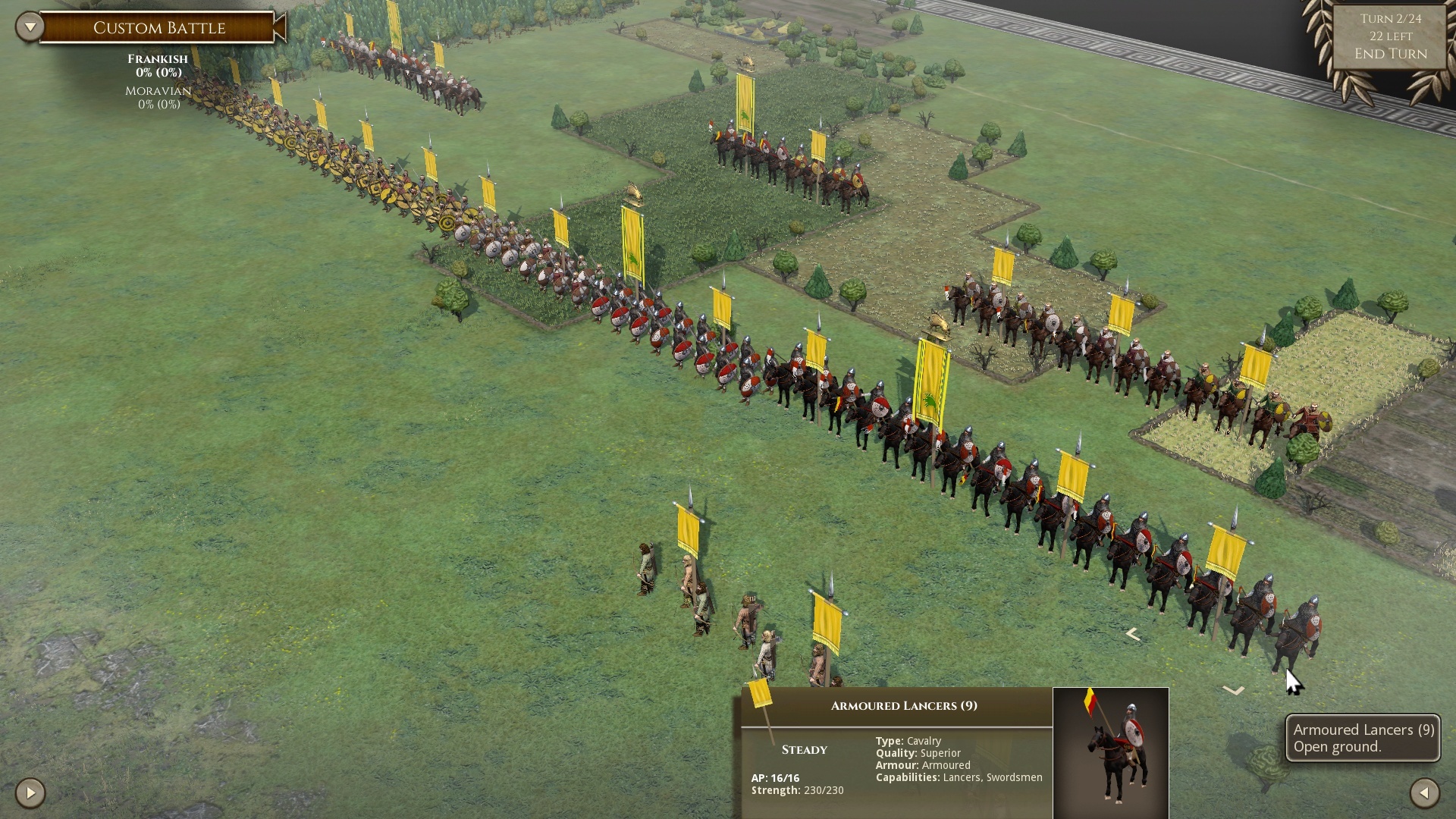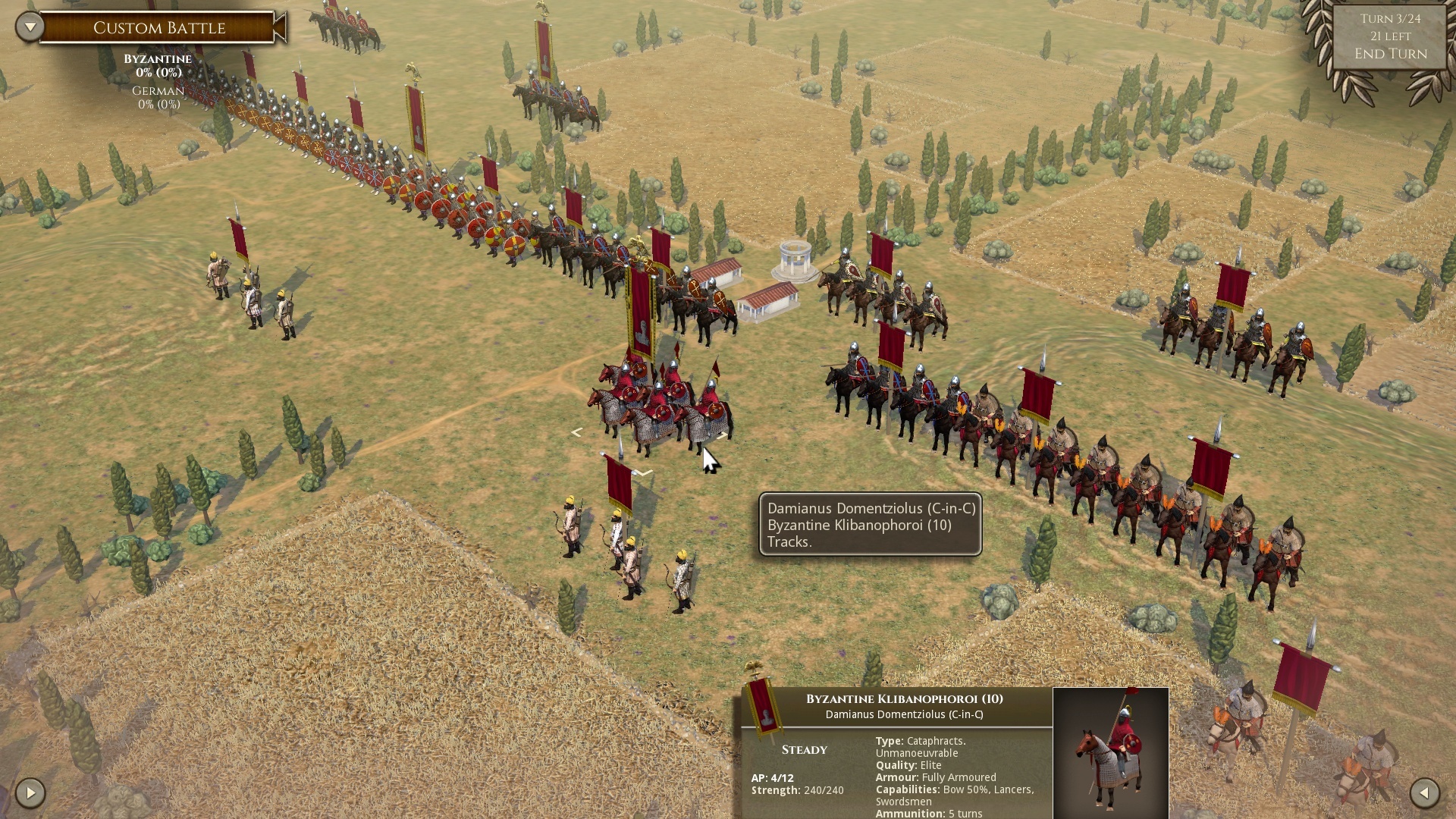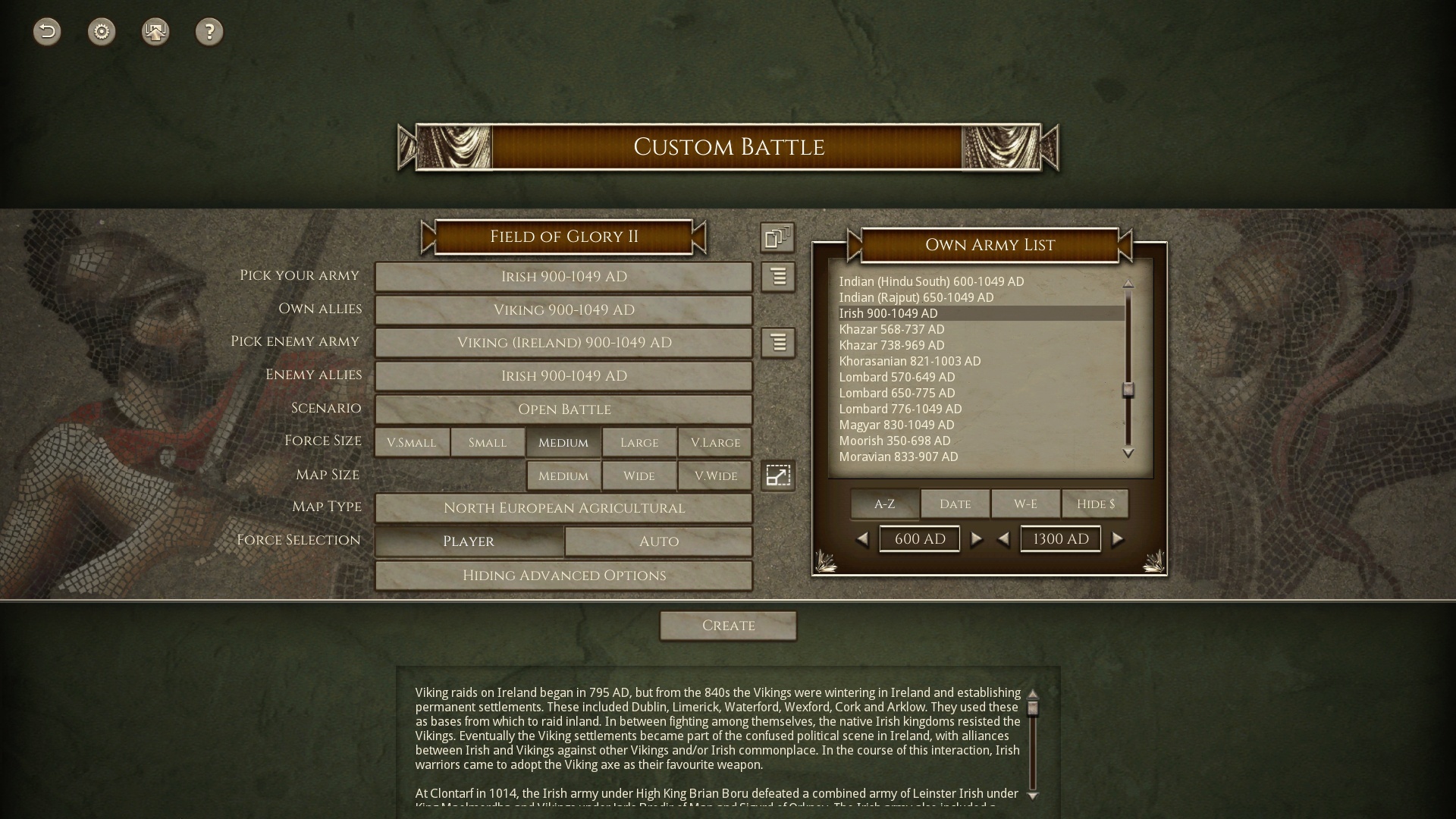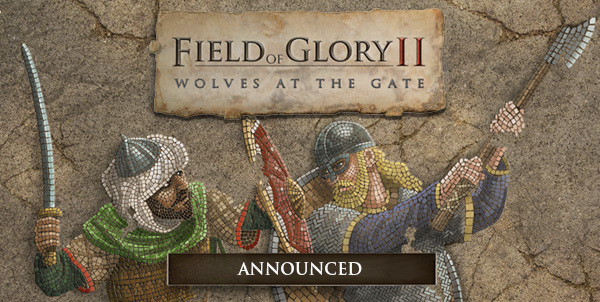
May 30, 2019
Field of Glory II - SlithFox
Field of Glory II has been updated to version 1.5.12, and it's massive!
Check the Changelog below.
v1.5.12 Changelog
Field of Glory: Empires:
• When Field of Glory: Empires is released, it will allow battles to be exported to be played out in FOG2. After the battle, FOG2 can be automatically closed and Empires opened, and the results of the battle imported into Empires.
https://store.steampowered.com/app/1011390/Field_of_Glory_Empires/
Allies:
• It is now possible to choose to have allies from a different army list in custom battle armies. The main army list will provide the majority of the troops available for selection, the allies will provide a smaller proportion.
• The permitted allies are specified in the ArmyList file – as previously used for sandbox campaigns - based on known historical alliances. For historical reasons, where a small country and a large country were allied historically, the smaller country will be specified as an ally for the larger country, but often not vice versa. This is when it is deemed historically unlikely that the larger country’s troops would form a minority of the army, even if, for example, it sent a force to assist a client in regaining his throne.
• When the Geographical and Date filters are turned on, the list of permitted allies is also filtered for geographical proximity to the enemy state and date compatibility with both the enemy army list and any enemy allies list.
• Allied troops in custom battles are not required to deploy together under an ally general. This is not entirely historical, but is a “quality of life” game design decision, to avoid issues with deployment and group moves.
UI:
• Cohesion test details, with a list of all modifiers that applied, are now shown in the combat log and detailed close combat reports.
Gameplay:
• Hotseat Custom Battles now allow manual force selection for both sides.
• Mediterranean, North European, Middle Eastern and Tropical Marshy terrain maps added.
• In random maps, vegetation has been added to marshes to make them easier to spot.
• Slings can now shoot overhead from higher ground.
• Lancers now get +50 Impact POA in open terrain vs steady, non-charging Pikes, Offensive Spearmen or Defensive Spearmen. (i.e. their normal +100 POA is only half cancelled against these).
• Cataphracts now get +50 POA for swordsmen capability vs steady Pike, Offensive Spearmen or Defensive Spearmen unless these are defending an obstacle. (i.e. their normal +100 POA is only half cancelled against these).
• Removed various “tells” giving away the position of hidden enemy units when they Fall Back, Form or Leave Square, Rout or Retreat. However, we have deliberately left in the notifications for units returning to the battlefield or rallying, even when these units are not visible, because otherwise players might think that the AI is cheating when these units reappear.
• Reduced number of additional generals available in tiny battles – this is primarily for very small Field of Glory: Empires battles.
• Xystophoroi now use a wedge formation of 5 figures. This is purely a change to the visual representation, because it looks cooler; nothing else has changed. The overall effects of their abilities and formation was already taken into account in their previous grading. Note that we are aware that some other historical units (e.g. Thracian heavy cavalry) also used wedge formation, but they share units with armies that didn’t, so we have left their formations unchanged.
AI:
• Flank charges against enemy that are not yet in combat moved to second AI pass so that other friends have the opportunity to engage the enemy first.
• Made retreating AI light troops do so on first AI pass even if Disrupted or Fragmented.
• Evady Cavalry/Camelry/Light Chariots will no longer allow themselves to be pinned by a light horse charge if they are also threatened with a possible flank/rear charge by non-light troops this turn. This was an unintended consequence of the previous change to prevent Cavalry/Camelry/Light Chariots from automatically evading from flank/rear charges by Light Horse. Note that it is still possible to pin them with light horse that start the turn in an adjacent square if the heavier charge threat is frontal.
• AI or pursuing cavalry will now never charge elephants unless the elephants are already Fragmented.
Multiplayer:
• Simplified retry process when sending End Turn or Save and Exit data if internet connection down or server does not respond. It is now only necessary to click the Proceed button on the "Failed to send the game to the server. Please check your connection and try again." popup to trigger the game to attempt to resend the data. Previously it was necessary to hit End Turn etc. again to trigger the resend, and there was a bug preventing a resend of a failed Save & Exit.
• Bugs affecting Mirrored MP challenges fixed. Mirrored Epic Battle challenges should now work correctly, but the fix only works for new challenges, not challenges created with previous versions of the game.
Campaigns:
• The AI side in “Ditch” battles, as found in Belisarius and Ashurbanipal campaigns, will now start advancing immediately.
• Campaign scoring now takes into account whether the campaign is being played on “Progressive” difficulty.
Campaign Design:
• TWEAK now works for all decision types except: 1, 2, (15, 18, 19 - these should not be used in custom campaigns anyway).
Units
• Massed Greek Peltasts unit added - for various army lists.
Unit Cost adjustments:
• Expert Armoured Horse Archers (and equivalent units) – reduced from 72 to 66 points.
• Armoured Horse Archers (and equivalent units) – reduced from 57 to 52 points.
• Byzantine Flankers – reduced from 52 to 48 points.
• Persian Improvised Camelry – reduced from 60 to 56 points.
• Byzantine “above-average” lancers & archers – cost reduced from 55 to 54 points.
• Zealots – increased from 51 to 57 points.
• Veteran Samnite Foot – increased from 63 to 66 points.
• Veteran Dailami Foot – increased from 54 to 60 points.
• Mediocre Legionaries – reduced from 60 to 54 points.
• Imitation Legionaries – reduced from 54 points to 51 points.
• Early Imperial Roman Auxilia – reduced from 48 to 42 points.
• Legio Comitatenses - reduced from 54 to 51 points.
• Thorakitai – reduced from 54 to 51 points.
• Well-Armed Slaves – reduced from 46 to 44 points.
• Cretan archers – reduced from 42 to 39 points.
• Balearic Slingers – reduced from 36 to 33 points.
• Assyrian-style Mixed Medium Foot (Protected) – increased from 42 to 44 points.
• Assyrian-style Raw Mixed Medium Foot (Protected) – increased from 30 to 32 points.
• Assyrian-style Mixed Heavy Foot – reduced from 60 to 56 points.
Army Lists:
• Major revamp to the Thracian army lists, based on the authoritative work of Chris Webber (aka vakarr) as in his Mercenaries and Allies Mod. The new main-game versions of his lists contain only vanilla units, but remain extremely interesting from a historical and tactical point of view. There are now 11 different Thracian army lists covering the different Thracian groupings from 700 BC to 46 AD. For further reading, consult Chris Webber’s works: “The Gods of Battle: The Thracians at War, 1500 BC - 150 AD” (Pen & Sword Military) and “The Thracians 700 BC-AD 46” (Osprey Men-at-Arms series).
• Jewish 167-111 BC list divided into 167-164 and 163-111 lists. The latter gets some xystophoroi and raw pikes. Increased number of pikes available in 110-64 BC list.
• Greek Armoured Cavalry added to Roman 105-25 BC list.
• Added alternative 272-273 AD Palmyran army list for those who take the view that Zenobia would not have access to any local Roman troops in the war against Aurelian.
• Palmyran army lists changed to use “Eastern” archers.
• Massed Eastern archers added to Achaemenid Persian lists.
• Increased number of pike units available in many Hellenistic armies.
• Split Ptolemaic 320-167 BC list into separate 320-218 and 217-167 lists.
• Roman 285-424 AD custom/campaign battle auto-deployment changed to non-chequerboard.
• Added Libyan 549-301 BC list and changed start date of following list to 300 BC.
• Added Kyrenean 321-276 BC list.
• Added Dacian (Carpi) 107-380 AD list.
• Removed built-in Sarmatian allies from Dacian lists. They can be fielded by using a Sarmatian ally. Also added some Superior warbands to Dacian lists.
• Added Greek (Mercenary) 460-281 BC list. (Xenophon campaign changed to use this for Anabasis phases).
• Indian 545-599 AD list changed to use Indian-style lancers.
• Massed Greek Peltasts added to various lists.
Editor:
• Units in Editor will now consistently show banners – red for side 0 and blue for side 1 (if vanilla banner textures are in use). Default sidenames switched to match.
• Units with Editor-placed generals will show long banners.
User Content Creation:
• Added ReSkinReinforcementUnit(id, reverse) function that can be used to reskin scripted reinforcement units with side-appropriate textures. Must be called once for each reinforcement unit after it is created in the scenario script. reverse == 0 means use usual side colours, reverse == 1 means use reversed side colours.
Manual:
• Slings can now shoot overhead from higher ground.
• Addition to Impact POA Chart: Lancers: (in open terrain only) +50 POA vs steady, non-charging Pikemen, Offensive Spearmen or Defensive Spearmen.
• Addition to Melee POA Chart: Mounted Swordsmen: +50 POA if Cataphracts vs steady Pike, Offensive Spearmen or Defensive Spearmen unless these are defending an obstacle.
Bug Fixes:
• Fixed bug that could sometimes cause group Undo to give extra AP to units that were blocked from moving in the group move. Note that the fix adds a slight (1-2 second) delay to the Undo icon appearing in group moves where a unit was blocked from moving.
• Fixed bug that could sometimes prevent a “Leave Square” move from being Undone.
• Plugged exploit where a unit blocking shooting could be moved out of the way so that the unit behind could shoot, and then Undo used to move the first unit back into its previous position.
• Fixed bug whereby a unit set as “Cannot Control”, and hence which could not be given single unit orders, could get included in a Group Move.
• Fixed issue of mixed units not showing all spearmen and archers in correct positions for a couple of seconds when first deployed or redeployed.
• Fixed bug that could cause game to crash in the few user-created Epic Battles scenarios using non-scripted reinforcements.
• Hopefully fixed rare bug where a dispersed unit sometimes continued to have a “ghost existence” – being invisible but targetable and blocking access to the square.
• Fixed two bugs affecting mirrored MP games. The fixes will only work for newly set up challenges, not for ones set up with the previous build.
• Fixed bug preventing resend of MP Save & Exit data if internet connect was down or the server did not respond on the first attempt.
• Fixed issue of very long MP chat messages getting truncated in the chat message display.
• Fixed bug that could prevent MP challenge from being created if player’s comment included the “/” character.
• Fixed MP bug that sometimes caused group turn made during side A’s deployment to be undone by Side B’s replay.
• Fixed disappearing shadows bug affecting Epic Battle maps with some sub 0 height level tiles (Granikos and Issos).
• Fixed team allocation (for player group moves) errors in Frigidus scenarios.
• Fixed bug that could sometimes prevent AI unit from turning to avoid being flank charged.
• Fixed bug that caused indecisive (nightfall) campaign victories to be listed as defeats in campaign score report.
• Fixed remounting bug on large units of dismounted noble lancers and armoured noble lancers. (They should not have been able to remount).
• Fixed bug that could show troop quality incorrectly in Multiplayer Skirmish setup Army List previews if game difficulty level set to Centurion or Deity.
• Fixed bug that prevented the map width from being reset to the appropriate narrower width when a smaller campaign battle follows a larger campaign or custom battle.
• Fixed bug that could allow pursuers to pursue off the map edge through terrain they would not normally pursue into.
Check the Changelog below.
v1.5.12 Changelog
Field of Glory: Empires:
• When Field of Glory: Empires is released, it will allow battles to be exported to be played out in FOG2. After the battle, FOG2 can be automatically closed and Empires opened, and the results of the battle imported into Empires.
https://store.steampowered.com/app/1011390/Field_of_Glory_Empires/
Allies:
• It is now possible to choose to have allies from a different army list in custom battle armies. The main army list will provide the majority of the troops available for selection, the allies will provide a smaller proportion.
• The permitted allies are specified in the ArmyList file – as previously used for sandbox campaigns - based on known historical alliances. For historical reasons, where a small country and a large country were allied historically, the smaller country will be specified as an ally for the larger country, but often not vice versa. This is when it is deemed historically unlikely that the larger country’s troops would form a minority of the army, even if, for example, it sent a force to assist a client in regaining his throne.
• When the Geographical and Date filters are turned on, the list of permitted allies is also filtered for geographical proximity to the enemy state and date compatibility with both the enemy army list and any enemy allies list.
• Allied troops in custom battles are not required to deploy together under an ally general. This is not entirely historical, but is a “quality of life” game design decision, to avoid issues with deployment and group moves.
UI:
• Cohesion test details, with a list of all modifiers that applied, are now shown in the combat log and detailed close combat reports.
Gameplay:
• Hotseat Custom Battles now allow manual force selection for both sides.
• Mediterranean, North European, Middle Eastern and Tropical Marshy terrain maps added.
• In random maps, vegetation has been added to marshes to make them easier to spot.
• Slings can now shoot overhead from higher ground.
• Lancers now get +50 Impact POA in open terrain vs steady, non-charging Pikes, Offensive Spearmen or Defensive Spearmen. (i.e. their normal +100 POA is only half cancelled against these).
• Cataphracts now get +50 POA for swordsmen capability vs steady Pike, Offensive Spearmen or Defensive Spearmen unless these are defending an obstacle. (i.e. their normal +100 POA is only half cancelled against these).
• Removed various “tells” giving away the position of hidden enemy units when they Fall Back, Form or Leave Square, Rout or Retreat. However, we have deliberately left in the notifications for units returning to the battlefield or rallying, even when these units are not visible, because otherwise players might think that the AI is cheating when these units reappear.
• Reduced number of additional generals available in tiny battles – this is primarily for very small Field of Glory: Empires battles.
• Xystophoroi now use a wedge formation of 5 figures. This is purely a change to the visual representation, because it looks cooler; nothing else has changed. The overall effects of their abilities and formation was already taken into account in their previous grading. Note that we are aware that some other historical units (e.g. Thracian heavy cavalry) also used wedge formation, but they share units with armies that didn’t, so we have left their formations unchanged.
AI:
• Flank charges against enemy that are not yet in combat moved to second AI pass so that other friends have the opportunity to engage the enemy first.
• Made retreating AI light troops do so on first AI pass even if Disrupted or Fragmented.
• Evady Cavalry/Camelry/Light Chariots will no longer allow themselves to be pinned by a light horse charge if they are also threatened with a possible flank/rear charge by non-light troops this turn. This was an unintended consequence of the previous change to prevent Cavalry/Camelry/Light Chariots from automatically evading from flank/rear charges by Light Horse. Note that it is still possible to pin them with light horse that start the turn in an adjacent square if the heavier charge threat is frontal.
• AI or pursuing cavalry will now never charge elephants unless the elephants are already Fragmented.
Multiplayer:
• Simplified retry process when sending End Turn or Save and Exit data if internet connection down or server does not respond. It is now only necessary to click the Proceed button on the "Failed to send the game to the server. Please check your connection and try again." popup to trigger the game to attempt to resend the data. Previously it was necessary to hit End Turn etc. again to trigger the resend, and there was a bug preventing a resend of a failed Save & Exit.
• Bugs affecting Mirrored MP challenges fixed. Mirrored Epic Battle challenges should now work correctly, but the fix only works for new challenges, not challenges created with previous versions of the game.
Campaigns:
• The AI side in “Ditch” battles, as found in Belisarius and Ashurbanipal campaigns, will now start advancing immediately.
• Campaign scoring now takes into account whether the campaign is being played on “Progressive” difficulty.
Campaign Design:
• TWEAK now works for all decision types except: 1, 2, (15, 18, 19 - these should not be used in custom campaigns anyway).
Units
• Massed Greek Peltasts unit added - for various army lists.
Unit Cost adjustments:
• Expert Armoured Horse Archers (and equivalent units) – reduced from 72 to 66 points.
• Armoured Horse Archers (and equivalent units) – reduced from 57 to 52 points.
• Byzantine Flankers – reduced from 52 to 48 points.
• Persian Improvised Camelry – reduced from 60 to 56 points.
• Byzantine “above-average” lancers & archers – cost reduced from 55 to 54 points.
• Zealots – increased from 51 to 57 points.
• Veteran Samnite Foot – increased from 63 to 66 points.
• Veteran Dailami Foot – increased from 54 to 60 points.
• Mediocre Legionaries – reduced from 60 to 54 points.
• Imitation Legionaries – reduced from 54 points to 51 points.
• Early Imperial Roman Auxilia – reduced from 48 to 42 points.
• Legio Comitatenses - reduced from 54 to 51 points.
• Thorakitai – reduced from 54 to 51 points.
• Well-Armed Slaves – reduced from 46 to 44 points.
• Cretan archers – reduced from 42 to 39 points.
• Balearic Slingers – reduced from 36 to 33 points.
• Assyrian-style Mixed Medium Foot (Protected) – increased from 42 to 44 points.
• Assyrian-style Raw Mixed Medium Foot (Protected) – increased from 30 to 32 points.
• Assyrian-style Mixed Heavy Foot – reduced from 60 to 56 points.
Army Lists:
• Major revamp to the Thracian army lists, based on the authoritative work of Chris Webber (aka vakarr) as in his Mercenaries and Allies Mod. The new main-game versions of his lists contain only vanilla units, but remain extremely interesting from a historical and tactical point of view. There are now 11 different Thracian army lists covering the different Thracian groupings from 700 BC to 46 AD. For further reading, consult Chris Webber’s works: “The Gods of Battle: The Thracians at War, 1500 BC - 150 AD” (Pen & Sword Military) and “The Thracians 700 BC-AD 46” (Osprey Men-at-Arms series).
• Jewish 167-111 BC list divided into 167-164 and 163-111 lists. The latter gets some xystophoroi and raw pikes. Increased number of pikes available in 110-64 BC list.
• Greek Armoured Cavalry added to Roman 105-25 BC list.
• Added alternative 272-273 AD Palmyran army list for those who take the view that Zenobia would not have access to any local Roman troops in the war against Aurelian.
• Palmyran army lists changed to use “Eastern” archers.
• Massed Eastern archers added to Achaemenid Persian lists.
• Increased number of pike units available in many Hellenistic armies.
• Split Ptolemaic 320-167 BC list into separate 320-218 and 217-167 lists.
• Roman 285-424 AD custom/campaign battle auto-deployment changed to non-chequerboard.
• Added Libyan 549-301 BC list and changed start date of following list to 300 BC.
• Added Kyrenean 321-276 BC list.
• Added Dacian (Carpi) 107-380 AD list.
• Removed built-in Sarmatian allies from Dacian lists. They can be fielded by using a Sarmatian ally. Also added some Superior warbands to Dacian lists.
• Added Greek (Mercenary) 460-281 BC list. (Xenophon campaign changed to use this for Anabasis phases).
• Indian 545-599 AD list changed to use Indian-style lancers.
• Massed Greek Peltasts added to various lists.
Editor:
• Units in Editor will now consistently show banners – red for side 0 and blue for side 1 (if vanilla banner textures are in use). Default sidenames switched to match.
• Units with Editor-placed generals will show long banners.
User Content Creation:
• Added ReSkinReinforcementUnit(id, reverse) function that can be used to reskin scripted reinforcement units with side-appropriate textures. Must be called once for each reinforcement unit after it is created in the scenario script. reverse == 0 means use usual side colours, reverse == 1 means use reversed side colours.
Manual:
• Slings can now shoot overhead from higher ground.
• Addition to Impact POA Chart: Lancers: (in open terrain only) +50 POA vs steady, non-charging Pikemen, Offensive Spearmen or Defensive Spearmen.
• Addition to Melee POA Chart: Mounted Swordsmen: +50 POA if Cataphracts vs steady Pike, Offensive Spearmen or Defensive Spearmen unless these are defending an obstacle.
Bug Fixes:
• Fixed bug that could sometimes cause group Undo to give extra AP to units that were blocked from moving in the group move. Note that the fix adds a slight (1-2 second) delay to the Undo icon appearing in group moves where a unit was blocked from moving.
• Fixed bug that could sometimes prevent a “Leave Square” move from being Undone.
• Plugged exploit where a unit blocking shooting could be moved out of the way so that the unit behind could shoot, and then Undo used to move the first unit back into its previous position.
• Fixed bug whereby a unit set as “Cannot Control”, and hence which could not be given single unit orders, could get included in a Group Move.
• Fixed issue of mixed units not showing all spearmen and archers in correct positions for a couple of seconds when first deployed or redeployed.
• Fixed bug that could cause game to crash in the few user-created Epic Battles scenarios using non-scripted reinforcements.
• Hopefully fixed rare bug where a dispersed unit sometimes continued to have a “ghost existence” – being invisible but targetable and blocking access to the square.
• Fixed two bugs affecting mirrored MP games. The fixes will only work for newly set up challenges, not for ones set up with the previous build.
• Fixed bug preventing resend of MP Save & Exit data if internet connect was down or the server did not respond on the first attempt.
• Fixed issue of very long MP chat messages getting truncated in the chat message display.
• Fixed bug that could prevent MP challenge from being created if player’s comment included the “/” character.
• Fixed MP bug that sometimes caused group turn made during side A’s deployment to be undone by Side B’s replay.
• Fixed disappearing shadows bug affecting Epic Battle maps with some sub 0 height level tiles (Granikos and Issos).
• Fixed team allocation (for player group moves) errors in Frigidus scenarios.
• Fixed bug that could sometimes prevent AI unit from turning to avoid being flank charged.
• Fixed bug that caused indecisive (nightfall) campaign victories to be listed as defeats in campaign score report.
• Fixed remounting bug on large units of dismounted noble lancers and armoured noble lancers. (They should not have been able to remount).
• Fixed bug that could show troop quality incorrectly in Multiplayer Skirmish setup Army List previews if game difficulty level set to Centurion or Deity.
• Fixed bug that prevented the map width from being reset to the appropriate narrower width when a smaller campaign battle follows a larger campaign or custom battle.
• Fixed bug that could allow pursuers to pursue off the map edge through terrain they would not normally pursue into.





